The Fiji Goshawk (Accipiter rufitorques) is a distinctive bird of prey endemic to the islands of Fiji in the South Pacific. With a striking appearance and unique features, this raptor captures the attention of ornithologists and bird enthusiasts alike.
Sporting a compact and robust build, the Fiji Goshawk exhibits sexual dimorphism, with females being noticeably larger than males.
Its plumage varies between individuals, ranging from dark brown to slate gray, often adorned with distinctive rufous-colored collars.
Agile and adept hunters, these goshawks primarily prey on a diverse range of birds and small mammals in the dense tropical forests that make up their habitat.
Unfortunately, the species faces challenges such as habitat loss and potential threats from invasive species, warranting conservation efforts to ensure the continued survival of this remarkable and endemic bird species in the unique ecosystem of Fiji.
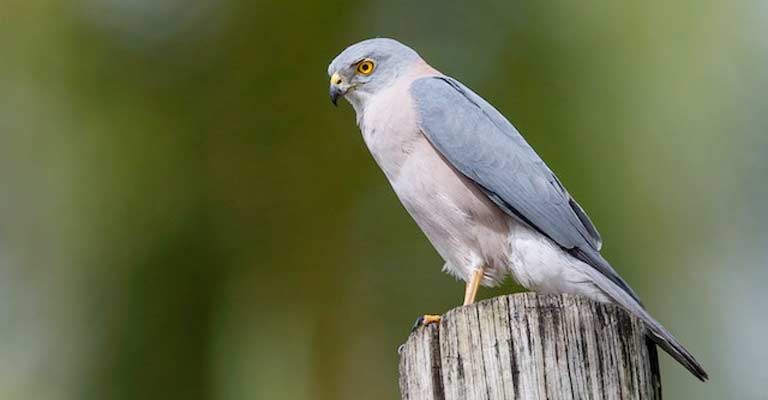
Taxonomy of Fiji Goshawk
Here is a table summarizing the taxonomy details of the Fiji Goshawk (Accipiter rufitorques):
| Taxonomic Level | Classification |
| Domain | Eukaryota |
| Kingdom | Animalia |
| Phylum | Chordata |
| Class | Aves |
| Order | Accipitriformes |
| Family | Accipitridae |
| Genus | Accipiter |
| Species | A. rufitorques |
The Fiji Goshawk (Accipiter rufitorques) belongs to the Animalia kingdom, Chordata phylum, Aves class, and Accipitriformes order. It is a member of the Accipitridae family, which encompasses various birds of prey.
Within the Accipitridae family, the Fiji Goshawk falls under the Accipiter genus. Its specific epithet is “rufitorques,” denoting the distinctive rufous-colored collar around its neck.
This bird’s taxonomy reflects its position as a bird of prey within the broader classification of the animal kingdom, with specific details highlighting its evolutionary relationships and unique characteristics.
Identifying Characteristics of Fiji Goshawk
Identifying the Fiji Goshawk (Accipiter rufitorques) requires a keen eye and an understanding of its unique characteristics. As an endemic species to the islands of Fiji, this bird of prey boasts distinct features that set it apart from other raptors.
Here are eight key points to consider when identifying the Fiji Goshawk:
Size and Shape
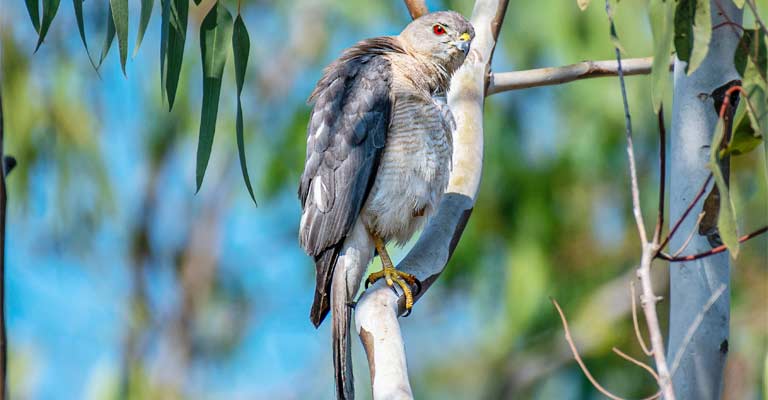
The Fiji Goshawk exhibits sexual dimorphism in size, with females being larger than males. Generally, they have a compact and robust build, characterized by broad wings and a relatively short tail.
This design reflects their adaptation to navigating through the dense tropical forests of Fiji with agility.
Plumage Variation
One of the most noticeable aspects of the Fiji Goshawk’s appearance is the variation in plumage. Individuals may range from dark brown to slate gray, and their plumage often features intricate patterns and markings.
The presence of a distinctive rufous-colored collar around the neck is a significant identifier, particularly in adults.
Eye Color
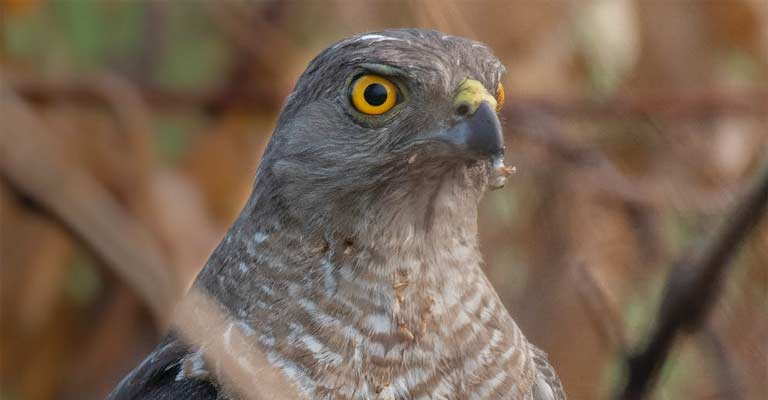
The Fiji Goshawk exhibits striking yellow eyes, which contribute to its intense and focused gaze. The eye color contrasts with the surrounding facial feathers, enhancing its overall captivating and predatory expression.
Distinctive Head Markings
Paying attention to the head markings is crucial for identification. Adult Fiji Goshawks often display a dark cap on their heads, which contrasts with the rest of the plumage.
This cap is more prominent in males, further aiding in distinguishing between the sexes.
Tail Bar Patterns
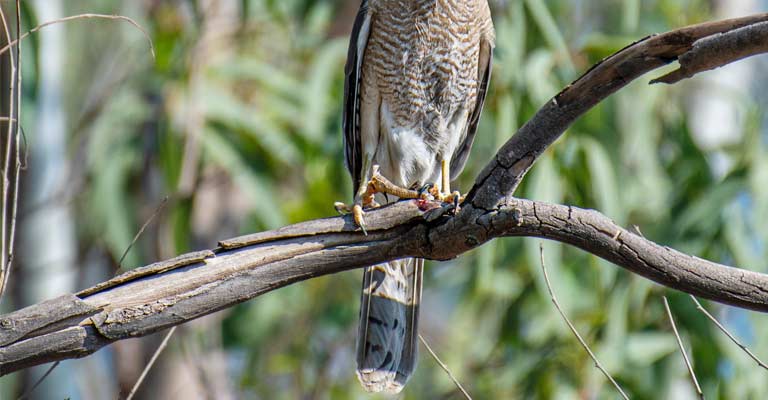
Observing the tail is essential for accurate identification. The Fiji Goshawk typically possesses distinct tail bars, which vary in number and intensity among individuals.
These bars are crucial markers when differentiating the species from other birds of prey within its habitat.
Hunting Behavior
Understanding the bird’s behavior can also aid in identification. The Fiji Goshawk is an agile and skilled hunter, often observed swiftly maneuvering through the forest canopy in pursuit of prey.
Observing its hunting techniques, such as sudden bursts of flight or rapid descents, can help confirm its identity.
Vocalizations
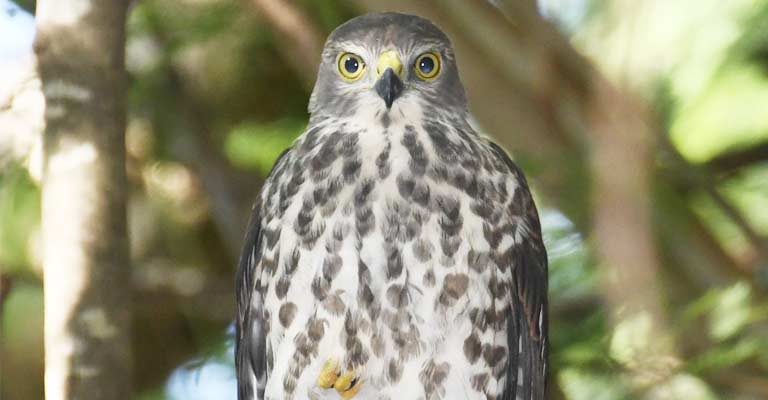
The Fiji Goshawk communicates through a variety of vocalizations, including sharp calls and whistles.
Familiarizing oneself with these distinctive sounds can contribute to accurate identification, especially when visual confirmation is challenging due to dense vegetation.
Habitat and Geographic Range
Finally, considering the bird’s habitat and geographic range is crucial. The Fiji Goshawk is restricted to the islands of Fiji, preferring dense tropical forests.
Recognizing the specific environment in which the bird is spotted can provide valuable context for confirming its identity.
Identifying the Fiji Goshawk requires a comprehensive understanding of its physical characteristics, behavior, and habitat.
By combining these key points, bird enthusiasts and researchers can confidently distinguish this remarkable and endemic species within the rich avian diversity of the Fijian archipelago.
Fiji Goshawk Life History
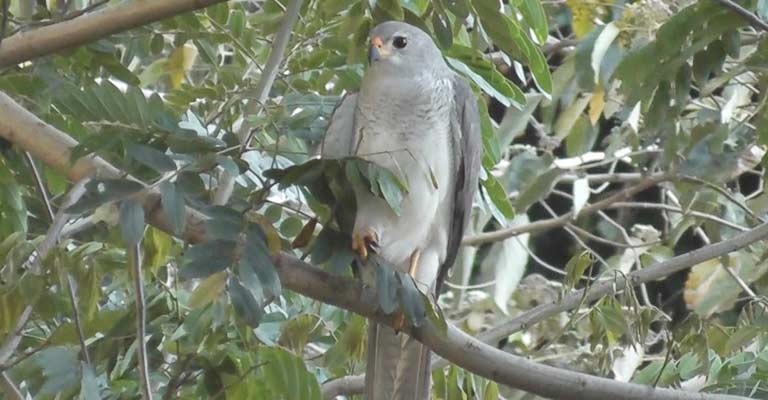
The Fiji Goshawk (Accipiter rufitorques) unfolds a captivating life history within the lush landscapes of the Fijian archipelago. This bird of prey, endemic to Fiji, exhibits intriguing behaviors and adaptations.
Exploring its life history unveils a tale of survival in a unique ecosystem.
Food
The Fiji Goshawk is a carnivorous hunter, preying on a diverse range of birds and small mammals. Its diet includes various species found in the dense tropical forests it inhabits.
Swift aerial pursuits and precise strikes characterize its hunting techniques, showcasing the bird’s adaptability to its environment.
Habitat
This raptor thrives in the dense tropical forests and woodlands of Fiji. The diverse vegetation provides both camouflage for hunting and suitable nesting sites.
The Fiji Goshawk’s ability to navigate through the intricacies of the forest canopy demonstrates its specialization for life in this habitat.
Range Map
The species’ range map extends across the Fijian islands, showcasing its endemism. From Vanua Levu to Kadavu, the Fiji Goshawk’s distribution reflects its dependence on the unique environmental conditions prevalent throughout the archipelago.
Nesting
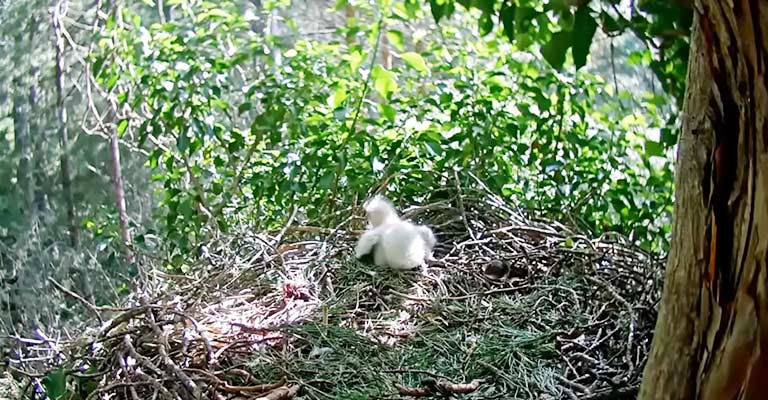
During the breeding season, Fiji Goshawks construct nests in the forest canopy. These nests are carefully crafted with sticks and foliage, camouflaged against the surrounding branches.
Female goshawks play a significant role in nest-building, ensuring a secure environment for the upcoming brood.
Here’s a table summarizing nesting details of the Fiji Goshawk (Accipiter rufitorques):
| Nesting Details | Facts |
| Clutch Size | Typically 2 to 3 eggs |
| Number of Broods | Usually 1 per breeding season |
| Egg Length | Approximately 50 to 60 mm |
| Egg Width | Around 40 to 45 mm |
| Incubation Period | Approximately 30 days |
| Nestling Period | About 35 to 40 days |
| Egg Description | Pale bluish-green with occasional spots |
| Nest Construction | Built with sticks and lined with foliage |
| Nest Placement | Constructed in the canopy of dense forests |
| Parental Involvement | Both parents participate in the incubation |
| Chick Development | Altricial, dependent on parents for care |
Breeding
Breeding occurs in response to seasonal cues. The female typically lays a clutch of eggs, and both parents collaborate in incubation duties. Once hatched, the chicks depend on the adults for nourishment and protection.
This phase marks a crucial period in the life history, shaping the next generation of Fiji Goshawks.
Diseases
While the Fiji Goshawk faces minimal threats from diseases in its natural habitat, environmental changes and the introduction of invasive species can pose risks.
Monitoring and understanding potential disease vectors are essential for conservation efforts to safeguard the population.
Treatment
Conservation initiatives often involve habitat protection, control of invasive species, and monitoring the health of individual birds. Prompt veterinary intervention may be necessary if disease outbreaks occur.
Collaborative efforts between conservationists and local communities play a vital role in ensuring the well-being of this endemic species.
Conservation
The Fiji Goshawk faces challenges due to habitat loss and potential threats from introduced species.
Conservation efforts focus on preserving its natural habitat, controlling invasive species, and raising awareness about the importance of this endemic bird in maintaining the ecological balance of Fiji’s ecosystems.
Through these measures, conservationists strive to secure a sustainable future for the Fiji Goshawk and the unique biodiversity of the Fijian islands.
10 Fun Facts About Fiji Goshawk
The Fiji Goshawk (Accipiter rufitorques), a captivating avian resident of the Fijian archipelago, boasts a myriad of fascinating features.
Beyond its distinctive appearance and predatory prowess, here are 10 fun facts that unveil the charm and uniqueness of this endemic bird.
- Endemic Marvel: The Fiji Goshawk is a species found nowhere else on the planet but in the tropical paradise of Fiji. Its exclusivity to this island nation adds an extra layer of allure to its identity.
- Sexual Dimorphism: The species displays sexual dimorphism in size, with females being notably larger than males. This size difference is a distinctive characteristic among these raptors.
- Variation in Plumage: Fiji Goshawks showcase a remarkable range of plumage colors, from dark brown to slate gray. This variation, coupled with intricate patterns, makes each individual a unique spectacle within the dense Fijian forests.
- Rufous Collar Signature: Adult Fiji Goshawks are adorned with a striking rufous-colored collar around their necks, setting them apart and adding a touch of elegance to their appearance.
- Acrobatic Hunters: Agile and adept in flight, Fiji Goshawks are acrobatic hunters, navigating through the dense forest canopy with impressive skill. Their swift maneuvers and sudden bursts of flight make them efficient predators.
- Distinctive Yellow Eyes: The intense yellow eyes of the Fiji Goshawk contribute to its fierce and focused expression. These eyes, coupled with its predatory instincts, enhance its ability to hunt successfully.
- Vocal Variety: Communicating through sharp calls and whistles, the Fiji Goshawk has a diverse vocal repertoire. These vocalizations play a crucial role in mate attraction and territory defense.
- Forest Dwellers: These raptors prefer dense tropical forests and woodlands, showcasing their adaptation to the complex environments of Fiji. Their specialized habitat choice reflects their dependence on the rich biodiversity found within the Fijian forests.
- Monogamous Bonds: Fiji Goshawks form monogamous pairs during the breeding season, showcasing a strong bond between mates. Both parents actively participate in nest-building, incubation, and the rearing of their offspring.
- Conservation Concerns: While the Fiji Goshawk is a resilient species, it faces threats such as habitat loss and potential impacts from invasive species.
Conservation efforts are crucial to safeguard the unique charm and ecological role played by this remarkable bird in Fiji’s delicate ecosystems.
Wrapping Up
The Fiji Goshawk stands as a symbol of avian uniqueness, an emblematic resident of the breathtaking Fijian landscapes.
From its exclusive endemism to the striking variations in plumage and the acrobatic prowess displayed in dense forests, this bird captures the imagination of bird enthusiasts and conservationists alike.
However, the Fiji Goshawk is not without its challenges. Conservation efforts are imperative to secure its habitat against encroaching threats.
As these raptors navigate the delicate balance of island ecosystems, the need for awareness, preservation, and sustainable practices becomes increasingly evident.
The Fiji Goshawk’s story is one of adaptability, resilience, and the interconnectedness between a species and its environment, underscoring the broader narrative of biodiversity conservation in the unique and irreplaceable ecosystems of Fiji.
In cherishing and safeguarding the Fiji Goshawk, we contribute to the preservation of a living testament to the ecological wonders of this Pacific paradise.
